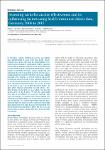Assessing varicella vaccine effectiveness and its influencing factors using health insurance claims data, Germany, 2006 to 2015
Rieck, Thorsten
Feig, Marcel
Heiden, Matthias an der
Siedler, Anette
Wichmann, Ole
In Germany, routine childhood varicella vaccination was implemented in 2004 with two doses recommended since 2009. We used an immunisation information system based on countrywide health insurance claims data to analyse vaccine effectiveness (VE) and factors influencing VE. We applied proportional hazard models to estimate VE under various conditions and compared the risk of acquiring varicella among unvaccinated children in regions with high vs low vaccination coverage (VC). Among 1.4 million children we identified 29,404 varicella cases over a maximum follow-up of 8 years post-vaccination. One-dose VE was 81.9% (95% confidence interval (CI): 81.4–82.5), two-dose VE 94.4% (95% CI: 94.2–94.6). With dose one given 1–27 days after measles-containing vaccine (MCV), one-dose VE was 32.2% (95% CI: 10.4–48.6), two-dose VE 92.8% (95% CI: 84.8–96.6). VE was not associated with age at vaccination (11–14 vs ≥ 15 months), time since vaccination, or vaccine type. Unvaccinated children had a twofold higher risk of acquiring varicella in low VC regions. Our system generated valuable data, showing that two-dose varicella vaccination provides good protection for at least 8 years. Unvaccinated children benefit from herd effects. When the first varicella vaccine dose is given shortly after MCV, a second dose is essential.
Dateien zu dieser Publikation
Keine Lizenzangabe

